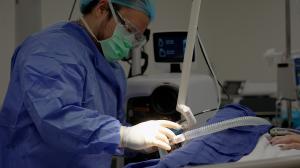Innovative Laser Therapy Gives Burn Survivors New Hope for Recovery
Laser therapy offers burn patients relief from painful and restrictive scars — improving mobility, reducing pain and transforming recovery with real results.
It’s changed my life. It’s helping me heal better, feel better and get to where I want to be.”
LUBBOCK, TX, UNITED STATES, July 8, 2025 /EINPresswire.com/ -- When it comes to managing the painful and restrictive scars left behind after burn injuries, treatments have come a long way. What was once limited to at-home care and bedside routines, such as scar massage, silicone bandages and compression garments, has now expanded into advanced laser therapy that can significantly improve both function and comfort.— Tonya Lambert
“Scar massage and compression therapy are still useful tools, but we now have far more effective options to address the deeper problems caused by hypertrophic scarring,” Alan Pang, M.D., burn and trauma surgeon at Texas Tech Physicians, said. “These scars can be painful, itchy and even limit mobility. Our laser procedure offers real relief.”
This cutting-edge treatment uses a specialized laser that fires tiny holes into thick scar tissue. The process is designed to stimulate the body’s natural healing response.
“Think of it as micro paper cuts,” Pang explained.
These tiny holes heal quickly, but they trigger a biological response that rearranges collagen. That helps the scar become softer and more pliable, improving range of motion and reducing pain.
Because of the discomfort involved in the procedure, essentially burning through dense scar tissue, it is done under sedation in an operating room. Patients are placed under anesthesis, the area is treated and they are sent home the same day. There is some soreness for a few days afterward, but it is managed with topical and oral pain relief.
For Tonya Lambert, a restaurant owner who suffered severe burns after a kitchen accident, this treatment became a turning point. After undergoing a skin graft that did not heal as expected, she turned to laser therapy in hopes of regaining comfort and mobility — especially in her foot, where a third-degree burn left her unable to wear a shoe.
“Every procedure gets a little bit better, a little less pain and I’m able to do a little bit more,” Lambert said. “The laser is doing exactly what Dr. Pang said it would.”
Patients typically begin to notice improvements within four to six weeks as their body reworks the internal structure of the scar. Most people see significant benefits after four to six sessions, though the number of treatments can vary depending on the severity and location of the scar.
The procedure isn’t just about aesthetics. This procedure frequently treats burn patients with scarring over joints, where thickened tissue can severely limit mobility. In addition to improving range of motion, the laser therapy also has proven effective for patients experiencing persistent itching or pain caused by nerve endings trapped in scar tissue.
“Without these laser treatments, I don’t think I would be able to be doing the things I’m doing now,” Lambert explained. “It’s not just helping the appearance of the burn. It’s helping with pain, healing and letting me get back to my life.”
While burn patients make up the majority of those treated, the laser procedure can be used for nearly any type of hypertrophic scarring, from post-surgical scars to injuries from accidents. As long as there’s abnormal scar tissue, it can be evaluated and likely treated.
“Our goal is always to improve quality of life,” Pang said. “And this laser therapy is helping us do that in a way we couldn’t before.” Ultimately, this modern technique represents a leap forward in scar care — moving from passive waiting to proactive, effective treatment.
Follow-up care is simple. Patients return to the clinic four to six weeks after the initial treatment to assess their progress and determine whether further sessions are needed. Pang mentioned this therapy isn’t a one-time fix for everyone, but it’s a powerful tool in helping patients heal and regain normal function.
“It’s changed my life,” Lambert said. “It’s helping me heal better, feel better and get to where I want to be.”
-30-
Krystal Meazell
Texas Tech University Health Sciences Center
krystal.meazell@ttuhsc.edu
Legal Disclaimer:
EIN Presswire provides this news content "as is" without warranty of any kind. We do not accept any responsibility or liability for the accuracy, content, images, videos, licenses, completeness, legality, or reliability of the information contained in this article. If you have any complaints or copyright issues related to this article, kindly contact the author above.

